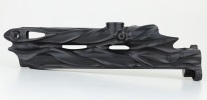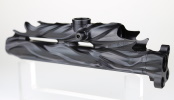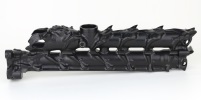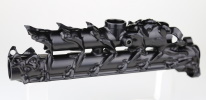Item Category Generic items: Air fittings ASAs and drops Barrels Camera parts Detents Feednecks Marker parts: Autococker Automag DLX Luxe Eclipse Empire Mini classic Empire MiniGS Empire Axe classic Empire Axe Pro FEP Quest Impulse BLAST / Field One Shocker Sport Shocker SFT / NXT Shocker RSX / XLS Shocker CVO Tippmann X7 Tippmann Crossover TM7 / TM15 Vanquish
Information Tech support Dealers Warranty Contact About Nummech Links Reviews Development lab Legal Promo images


Development lab: N-Autococker bodies Welcome to another tech article about making a paintball marker body!

Nummech has manufactured many marker bodies over the years, ranging from prototyping to large-scale production, but the "old school" markers like Automags and Autocockers present some new aspects to the machining process. The first factor about Autococker bodies is that they're actually quite basic compared to some of the so-called modern marker bodies that we've made (such as those for an Empire Axe). Modern markers follow the trend of shrinking the marker while also using more complex internals, so their level of detail is extremely high. Old-school markers like Autocockers are more basic and spread-out, so creating a new body is certainly an easier task.
However, despite being easier compared to a modern marker, the precision of a marker body is still present in Autocockers and Automags. As I've mentioned before, machining ANY marker body from scratch is extremely difficult compared to most internal components found within the marker itself. Even a grip frame is more basic since it's primarilly an "ergonomics" component, unlike the body which requires heavy internal cuts with a high level of accuracy.
In order to create a new Autococker body, I needed measurements of the original ones. I obtained a number of test markers spread across all years of WGP production then measured all of them. The good news is that almost all WGP bodies were identical until the Karnivore days (when the front block changed), then the newer Empire Resurrection/Sniper changed the marker design further (midblock bolt design, new frame screw size and pattern, etc). It's not possible to make a one-size-fits-all Autococker since there's soooooo many variations, but we narrowed it down to starting with a full-length "2k-style" body as the basis, then the future plan was to convert that original marker into a midblock as well. (meta note: this goal was successful and ended up being released at the same time).
Here's a full list of specs and aspecs for the new bodies. This same list appears on the store page for the finished body, but the store page is abridged for clarity.
- Lower bore internals: The bodies will use 11/16" valves because this is easier to machine compared to the older jam-nut style valves. Through this method, the lower bore is reamed then honed to the finished diameter of 0.700" all the way up to the front frame screw.
- Banjo: Same banjo as 2k-style cockers.
- Upper bore: The bodies will use the same diameter upper bore as WGP bodies, which is exactly 11/16" (0.689"). This is different compared to Empire Autocockers that use a 0.700" upper bore, but most bolts made for Resurrections/Snipers are also compatible with an 11/16" upper bore if you use slightly smaller o-rings for a better fit.
- The bodies will use new back blocks and front blocks which will be milled to match.
- Detents: For simplicity I prefer to use the threaded detent style because these are readily available and very easy to support. The advantage of using the newer "nub" detents as with an Empire marker is that they are cleaner when viewed from the outside. However this requires manufacturing a separate item (eye covers) and sourcing rubber detents which I don't want to persue at the moment. The problem with Empire's eye cover system was that there never was a finished product that actually supports them, instead they became a future-proofing feature that was never capitalized upon. I don't want to spend the resources to mimick the covers since they had no other benefit besides retaining the nub detents.
- Feedneck: All our marker bodies use the superior Empire-spec feedneck latch. In our newer markers, the feedneck is offset to the side by a tiny amount, though not as much as Eclipse markers for detent-compatibility reasons.
- Barrel: Autococker threads since they're popular. The bodies will use the "fast cocker" thread where the first couple threads are eliminated to make barrels easier to install.

Above: CAD model for Nummech Autococker body
Now the task is to put it all together into a design that can function as an unmilled blank, which is the first step for making finished bodies. The only difference with these cocker blanks using a wider chunk of material compared to most other Autococker bodies; we start with a piece of material measuring 1.250" wide rather than 1.0" as with WGP bodies. Technically WGP bodies came from special extrusions that didn't allow for additional material on the sides, but I wanted to ensure plenty of raw material would be available for whatever crazy cosmetics come up in the future.
Prototype bodies: (serials 1 to 2) The date is April 2018; I wanted to finish the test bodies in time for the Living Legends 2018 game in May, so it was about a month's time. I was simultaneously working on prototype bodies and grip frames in time for the event.
Once the design was laid out, it was time to make some test components. You may recall I described these markers as being "easier to make" but the bodies still need to be tested. First, the machining process needs to be debugged to create a more reliable machining process in the future. Second goal is to test the new body's few design deviations that make them unique from typical Autocockers. The third goal was to gather required data on the manufacturing time which is used in determining costs associated with the new products.
Our "production batch" of marker bodies are normally manufactured in groups of four per cycle within the CNC machines, but I only need a pair to actually fulfill the prototyping goals from above. We never make one quantity of anything because of the high costs involved, so that means bodies number 1 and 2 would get created during this time trial. I decided to slice up two full-length aluminum extrusions which was theoretically enough material to make around 3 dozen bodies. I only planned to make two FINISHED bodies, so the remainder of the material would be used for additional bodies in the future (meta note: the remaining material would be used for "pre-production" bodies which are described further down the page).
To recap, bodies numbering 1 through 36 would be started in this batch, but only bodies 1 and 2 would be carried on for completion during the prototyping. There's a high chance that they would be functional but nothing is ever guaranteed. It's almost certain that the cosmetics would need adjustments and refinements simply because the highly-detailed contours are very intricate and will experience a few little quirks here and there. Whether or not the bodies would end up being "presentable" is a different story. Usually the cosmetic milling is mostly correct, but we usually don't use the prototypes for promotional pictures. It's also worth mentioning that historically the very first body is almost never used to create a finished marker, although the specific reason varies from marker to marker (it could be defective internals, incompatibility with other parts, bad milling, etc).
Onto the protyping! The first couple operations went off without a problem since the body design is fairly straightforward. First the bottom cuts were created, then the main bores were drilled all the way through the blanks. The serial engraving also takes place during this step, so all the bodies are initially engraved during this phase of the production. The main bores are drilled and reamed, but not yet honed because the cosmetic cuts may cross into the upper bore which would need to be honed after cosmetic milling was completed.
At this stage, the most difficult parts have been completed. The bodies are nearly functional but they require a feedneck port and detent drilling, and also they need a slot for the pump arm on the left side. These final cuts are done along with the cosmetics, so we have almost arrived at the cool cosmetic milling step that everybody wants to see. BUT there's one thing that has to happen first...the front and back blocks! I need to prototype those components too, because the goal is to mill all the items simultaneously within the same setup in the CNC.
Luckily the front block and back block are very simple components compared to the rest of the marker body. The blocks are milled as a pair using the same setup in the machine, which consists of a two-operation program that finished the "front" and "back" surfaces along with all those main holes and features. When completed, the blocks are rough on the outer surfaces since they will be finished later.



Above: Unmilled front and back blocks
The only reason these parts couldn't be utilized right now is because the back block doesn't have a cross-hole drilled for the bolt pin. This feature is also created alongside the cosmetics.
With the back block, front block, and body blank now finished, we're almost ready to enter the cosmetic milling. There's still some steps remaining, though. The first item is I need a new fixture in order to hold an Autococker body within the machine. I call this component an "upright" since its job is to keep the body away from its mounting surface; it's a T-shaped chunk of aluminum that acts as a go-between with the CNC's mounting fixture. We make these components for any new marker body because it's a standardized system used when producing any of our production-level bodies.

Above: Body installed in CNC machine
Not done yet, though. There's yet another set of "fixture" components required, which are the items needed to mount the front and back blocks onto the milled body itself. This concists of the following items: (1) a dummy IVG that has a threaded hole in the middle which will be used to attach the back block; (2) sacrificial banjo screw that holds the front block onto the body; (3) a plug for the upper bore that prevents the back block aligned with the body.
The front block and back block also have small 1/8" pins which are used for alignment. The pins cannot be used on their own, though, which is why the upper bore alignment plug was made. The front block doesn't need anything else since it has the large banjo screw holding it on, which is sturdy enough to keep it from moving around. The cool thing about this design is that the 1/8" pins can also be used once the marker is finished, so the front block will still maintain its alignment perfectly.

Above: Body fixturing hardware
Naturally I chose to use the pyro-style cosmetics to demonstrate the new design, since it's my most-popular milling pattern. The milling has a high level of complexity but still not as much compared to some other designs that we've done in the past (Necro etc).


Above: Pyrococker machining
When the body was complete, I assembled it with some of the test-model Nautococker hoseless frames in order use both sets of parts for testing on the field. At this time, I only had a hinge frame in my possession since the slider frames were all being tested already, but the hinge shape was catchy enough to gain attention to the frame because no other aftermarket companies were making them available (at the time).



Above: Assembled Pyrococker with Nac hoseless hinge frame
Permalink: https://www.youtube.com/watch?v=YRoGQErbXtE
"Pre-production" bodies (serials 3 to 36) Now that the prototype markers were finished and testing was going well, it was time to work the rest of the material that had been prepared earlier. The small assortment of body blanks were already completed, so they only needed cosmetics to be grafted onto them. The timeline for finishing these bodies was perfect because we were already in the process of milling some new N-Mag Unibodies using the same CNC fixture, so we're able to jump from one body to another with minimal downtime. Once the N-Mag bodies were finished up, I converted the machine back over for Autococker bodies, then embarked on the path to finish all them up.
There were very little differences between the pair of prototypes and the remaining pre-production markers. The main changes were in relation to the fixturing, because I ran into some alignment problems with the front block. The 1/8" pinholes were a good idea but their holes needed to be drilled deeper. Additionally, in order to produce more bodies in a quicker amount of time, I needed to create more of the fixturing tools that would be used to stage new bodies waiting to be milled. Through this strategy, the changeover time between bodies becomes minimalized even further (and it's also possible for the machine to finish multiple bodies at once, but that isn't the plan for only 35 bodies in this batch).
Once the batch was complete, we put them through the finishing process which involves a combination of manual and automated deburring. This is also when the bodies are finish-honed for the correct internal surface finish.



Above: Pyrococker bodies during the finishing process
All of these bodies were milled into full-length Nummech Pyrocockers. When they were completed, about half were anodized in typical black gloss, then left the other half raw. When they were offered for limited sale, the raw bodies went out to people that were interested in building custom-anodized markers from the ground-up. Regardless of finish, the body kits include the matching back and front block, a pyro-milled bolt pin, pyro-milled beavertail, and pair of ball detents. We also have feednecks available which are a good match for the body, but we're not mandating them to be sold with each marker because these bodies can be used with other feednecks if the owner wishes to go a differnt direction. That said, our feednecks are superior in nearly every way, so if you're looking for pure function then ours is the way to go.
Out of this small batch of Pyro bodies, two blanks were set aside for a secret project to develop some new cosmetics. I wasn't sure whether it could be done, but this project was actually for the first stacked-tube Necrococker body. Before this time, the Necro-style cosmetics were only used with single-bore markers such as Shockers, Axes, and Automags. I had never adapted it for a stacked-tube marker and I wasn't sure how it would end up. Despite that, I did my best to create an interesting new pattern that would certainly be unique if nothing else. Regardless, I wanted to give it a try, so I laid out the new design and found some time to prototype it.
The day came for testing the Necrococker cosmetics. I was still unsure whether it would be cool enough to sell, even though the CAD simulations showed a realistic preview of the shape. It wasn't until the cosmetics were underway that I got the first glimpse of the milling:

Above: Picture of the Necrococker prototype (with milled "windows"). Note: this marker does not have the usual text "prototype" like many of other other first-run bodies, but it's serial number NAC-020.
I was in love with this design! It's a very "busy" milling pattern that some people don't enjoy, but for those of us that like the extreme milling....well this is maximum-extreme when it comes to milling complexity. I made two versions, with and without windows in the upper tube. The windowed version looks very skeletonized but is perhaps too much milling. It was decided to stick with the "no window" design rather than use the more elaborate windowed style since it would have greater compatibility with random Autococker bolts floating around. Either way, the Necro milling pattern requires about 20% more machining time compared to the stacked-tube Pyrocockers, so these bodies would ultimately see a higher pricetag. However, the price increase is only 12% higher, because ensuring the bodies are accessible to people is a higher priority.

Above: Necrococker back from anodizing.
We had a huge interest from players for the bodies in this pre-production batch. The Necrococker became very popular, and naturally the smooth and curvy Pyrocockers became a great example of high-end milling with a classic marker platform. We knew that more bodies were needed but it would require much more work to build them!
Permalink: https://www.youtube.com/watch?v=FAhK3j8Avco
Midblock vs Full-length While the full-length bodies tend to be popular with old-school Autococker players, the "mid-block" design has become a popular alternative in recent years. Midblocks are cool because they reduce the external moving parts, and I have to admit they're also a little easier to manufacture since they don't require a back block component. It's not to say that either marker is superior than the other, it's just a preference between players. The goal is to provide items for both of those groups!
Accordingly, we needed to make a midblock deviation from the original Nummech body design, then set plans for making both styles simultaneously. The midblocks feature a very similar design as their full-length counterparts, however the midblocks include some modified cuts within the upper tube which accomodates the bolt's sled. Additionally, the bottom of the body is slightly different because the midblock bodies don't require a beavertail screw. Each body is still engraved with its own serial number at the front. Besides for those minor changes, the mid-block and full-length body designs are virtually identical.

Above: Midblock design for the pyrococker milling graft
There was one pre-production body leftover from the first collection of bodies, so it became the first midblock marker. And it was also the first midblock Necrococker too!


Above: Prototype Necrococker midblock
The midblock Necrococker (above) has few changes compared to its full-length brother. The area located behind the bolt is the only main alteration, since it has additional bone structure above the lower tube. In contrast, the midblock Pyrococker has many changes. Realtically the entire top surface of the upper tube has been re-modeled, and the upper tube's main flame cuts are also drastically more complex compared to the full-length Pyrococker. Even the area surrounding the barrel has been adjusted to offer asymmetry. In fact, the entire upper tube is entirely asymmetrical from left-to-right, in both the simple flame cuts and the 3d-machined fire shapes. The midblock Pyrococker is likely my most asymmetrical design to date.
Production "June 2019" bodies (serials 37 to 211) The pre-production bodies sold very quickly so we needed to begin working on the larger batch almost immeditely afterward. The goal for this batch was two-fold; we needed to make a fairly noticeable amount of bodies to keep up the supply, but we also needed to work on the midblock version at the same time. So ultimately the batch was divided approximately in half, between a combination of full-length and midblock bodies.
This is a fairly large batch of bodies that would require a noticeable quantity of material; specifically around 10 bars of aluminum that arrives in 12-foot extrusions. Those bars are sawed into lengths that leave extra material on the front and back which is milled to exact length during the machining process.


Above: Unmilled body blanks at various stages of milling
Above: Rough-milling operation on a Necrococker full-length body.
Above: Finish-milling on a Necrococker midblock body.
Production began with full-length bodies then ended with the midblock versions. Below you can see a few pictures of the various body batches, which are mixed together.



Above: Nummech bodies after machining




Above: Small collections of assorted secondary parts
After some cleanup, the bodies are finally ready to head out for anodizing along with all their matching components.


Above: Raw cockers
For anodizing, the marker bodies are racked using some of the non-critical features from the underside. This allows the entire marker body to be cleanly anodized and sealed without touching any of the marker's inside or outside.





Above: Markers back from black anodizing
Finished builds Below you can see some good examples of finished marker builds using the Nummech body as a basis. The first set of marker pictures feature a Nummech body with other 2k-style grip frame.
















